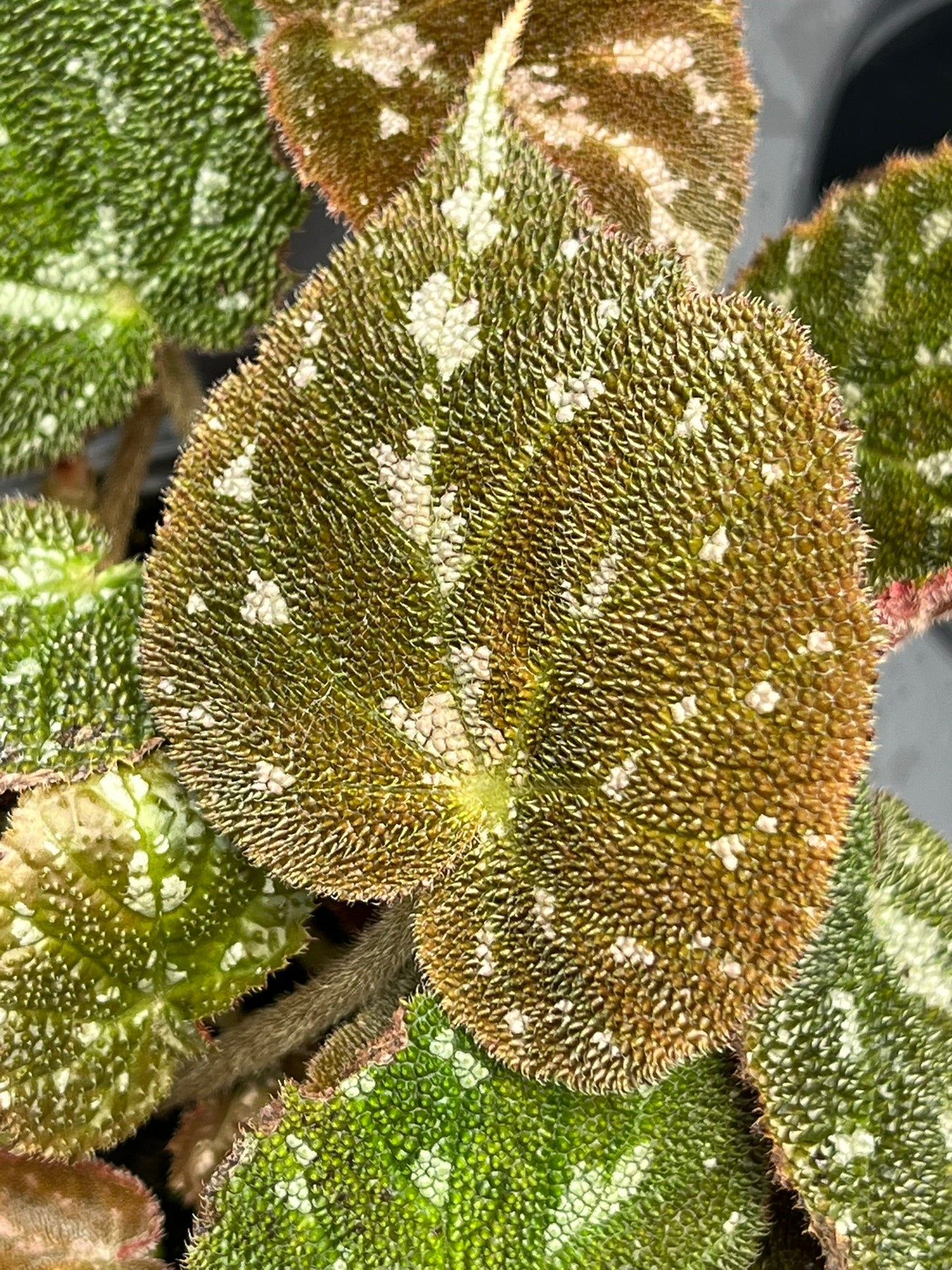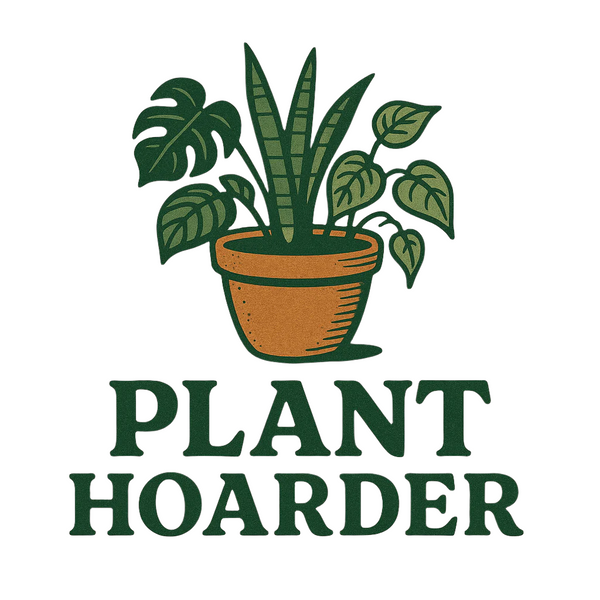Plant Hoarder
Begonia pustulata
Begonia pustulata
Couldn't load pickup availability
Share
Hardiness Zone:9
Sun Exposure:Part Sun, Mostly Shade and Shade
Begonia pustulata: A Rare Beauty With Dappled Leaves and Tropical Flair
If you’re looking for a showstopper houseplant or greenhouse specimen that combines both elegance and personality, Begonia pustulata might be exactly what you need. This rare species from Central America isn't just another pretty leaf—it's a botanical gem with shimmering silver spots, deep green texture, and a growth habit that’s as charming as it is manageable.
Let’s dig into what makes this begonia so special—and how you can grow it successfully at home.
What Is Begonia pustulata?
Begonia pustulata is a tropical rhizomatous begonia species that hails from the cloud forests of southern Mexico and Central America. It grows naturally in warm, humid environments under the canopy of taller trees. Its leaves are what steal the spotlight: deep green with a velvety feel and decorated with eye-catching silvery or pale green pustules (little raised bumps). These give the plant a shimmering, almost bejeweled look—especially under dappled light.
The name "pustulata" refers to these tiny, wart-like growths on the leaf surface. But don't let that word fool you. This plant is nothing short of stunning.
Why You'll Love It
-
Unique Foliage: No two leaves are alike. The silver spots catch light in amazing ways.
-
Compact Growth: It grows low and wide, making it ideal for containers or display shelves.
-
Tropical Vibes: Perfect for anyone building a lush, indoor jungle.
-
Rare but Growable: While it’s not common in big box stores, it’s surprisingly easy to care for once you meet its needs.
Light Requirements
Begonia pustulata thrives in bright, indirect light. Think of filtered sunlight—like what it would get under a forest canopy. If you give it too much direct sun, its leaves may burn or fade. Too little light, and it may get leggy or lose its vibrant leaf markings.
Best locations:
-
East-facing windows
-
Bright north windows
-
Near a west or south window, but behind sheer curtains
If you're growing under lights, go for a gentle LED setup that mimics daylight.
Watering and Humidity
Like many rhizomatous begonias, Begonia pustulata likes its soil moist but not soggy.
-
Water when the top inch of soil feels dry.
-
Avoid letting it sit in water—good drainage is a must.
-
Reduce watering slightly in winter.
This plant loves humidity. Aim for 50–70% relative humidity if you can. If your home is dry, consider:
-
A pebble tray with water beneath the pot
-
Grouping it with other plants
-
Using a small humidifier
Soil Mix
Begonia pustulata prefers a light, well-draining mix. It hates wet feet. A good recipe includes:
-
1 part peat moss or coco coir
-
1 part perlite
-
1 part orchid bark or leaf mold
This mix holds moisture but drains fast—perfect for preventing root rot.
Temperature Needs
Keep things warm and steady. Begonia pustulata doesn’t like the cold.
-
Ideal temperature: 65–80°F (18–27°C)
-
Avoid drafts, cold windowsills, or temps below 55°F (13°C)
This is definitely an indoor or greenhouse plant in temperate zones.
Fertilizer and Feeding
Give it a little boost during active growth (spring through early fall):
-
Use a balanced liquid fertilizer diluted to half strength.
-
Feed every 3–4 weeks during the growing season.
-
Stop feeding in winter when growth slows down.
Too much fertilizer can burn the roots or fade leaf colors—less is more here.
Potting and Repotting
Repot only when the plant outgrows its container or becomes rootbound. You’ll know it’s time when:
-
Roots peek out of the bottom
-
Water runs through too fast
-
Growth seems to stall
When repotting:
-
Choose a pot only 1–2 inches wider than the current one.
-
Use fresh soil mix.
-
Be gentle with the roots—rhizomes are delicate.
Propagation
Want to make more? It’s surprisingly fun.
How to propagate Begonia pustulata:
-
Take a piece of rhizome with a few leaves attached.
-
Lay it on top of moist soil or sphagnum moss.
-
Cover lightly and keep warm and humid.
-
Roots and new shoots will form in a few weeks.
You can also take leaf cuttings if you’re feeling adventurous.
Common Issues and Solutions
Let’s troubleshoot a few things you might run into:
-
Leaf edges turning brown? Dry air or under-watering.
-
Leaves losing spots? Not enough light.
-
Mushy rhizomes? Overwatering or poor drainage.
-
Powdery mildew or leaf spots? Improve airflow and avoid overhead watering.
Most issues can be avoided with the right balance of humidity, light, and careful watering.
Styling Tips: Where to Show It Off
Begonia pustulata is a conversation piece. Here’s where it shines:
-
In a wide, shallow ceramic planter on a coffee table
-
On a shaded plant shelf with ferns and mosses
-
Inside a terrarium (as long as it’s not sealed too tightly)
-
As a focal point in a tropical-themed room or sunroom
Pair it with trailing plants or contrasting foliage like calatheas or peperomias.
Is It Pet Safe?
Unfortunately, no. Like most begonias, Begonia pustulata is toxic to pets if ingested. Keep it out of reach of cats and dogs who like to nibble.
A Few Final Thoughts
Begonia pustulata isn’t just another fancy leaf—it’s an experience. It brings a bit of the tropical forest into your home. It asks for a little care and attention, but in return, it rewards you with lush, textured beauty every single day.
Once you see those shimmering silver pustules up close, you’ll understand why collectors treasure it. It’s rare, but it’s real. And yes—you can grow it.
Would you like help finding sources to buy Begonia pustulata or setting up the perfect indoor display?


